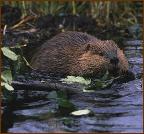mouse over picture
to enlarge


The fur trade was based on good relationships between the First Nations peoples and the European traders. First Nations people gathered furs and brought them to posts to trade for textiles, tools, guns, and other goods. This exchange of goods for other items is called the barter system. Each party would bargain to try to get the best value for the thing they were trading. The exchange benefited both of the trade partners because they each had something that the other valued and did not have.
Beaver was so valuable that it became almost like money. The values of all other furs and trade goods were determined by comparing their worth with that of a Made Beaver pelt. These tables (click here) are a sample of the values of some trade goods in Made Beaver (MB):
The values of goods in Made Beaver often changed for many reasons. Season, location of the post, competition from other trade groups, the size and quality of the pelts, and the availability of furs all affected the value of goods being exchanged.
The First Nations people were trading furs, which they could easily trap, for tools made from metal. At the time they did not have the technology to forge iron. Fabric and glass beads were also popular trade items. Women could sew clothing, saving themselves the lengthy process of scraping and tanning skins. The beads were used to decorate the clothing. Porcupine quills had been used before the beads became available. The quills had to be plucked, cleaned, flattened and dyed before they were used. Therefore the beads saved the women a great deal of labour.
In Europe most of the forests had been cleared for agriculture, so there was not enough fur bearing animals to meet the demand for fur clothing. The beaver had been hunted to extinction. It was particularly valued because its pelt could be made into felt which was used to make hats. The hats, like the decorations on First Nations clothing, conveyed messages to other members within the community, about the wealth, status, or even the profession of the wearer.


